Managing microservices across multiple cloud providers is a growing challenge, especially with 90% of large enterprises adopting multi-cloud strategies by 2025. Service mesh tools help simplify this by ensuring secure, reliable communication between distributed services without altering application code. Here's a quick summary of the top tools:
- Istio: Advanced features for complex multi-cloud environments but requires careful management due to its steep learning curve.
- Linkerd: Lightweight and simple, ideal for teams prioritising ease of use and cost efficiency.
- Consul: Great for hybrid setups, supporting both VMs and containers.
- Cilium: High performance and security with its sidecar-free, eBPF-based design.
- Open Service Mesh (OSM): A lightweight, Kubernetes-native option for straightforward deployments.
Quick Comparison
| Feature | Istio | Linkerd | Consul | Cilium | OSM |
|---|---|---|---|---|---|
| Multi-Cloud Support | Advanced | Basic Kubernetes-focused | Hybrid with VM support | Kubernetes-focused | Basic Kubernetes-native |
| Security Features | mTLS, RBAC, fine-grained | Automatic mTLS | mTLS, ACLs, segmentation | API-aware policies, mTLS | mTLS, SMI-based controls |
| Deployment Complexity | High | Low | Moderate | Moderate | Low |
| Observability | Deep tracing, advanced | Real-time metrics | Good monitoring integration | Kernel-level visibility | Basic metrics integration |
| Performance | Moderate (sidecar overhead) | High (lightweight design) | Moderate (sidecar model) | High (eBPF-based) | Moderate (lightweight) |
Choosing the right service mesh depends on your organisation’s infrastructure, team expertise, and priorities like cost, security, and ease of deployment. Each tool offers unique strengths for multi-cloud setups, but careful evaluation is key to aligning with your goals.
Leveraging Service Mesh For Enterprise Multi-Cloud Strategy- Jun Wei & Victor Martinez, Equinix
1. Istio
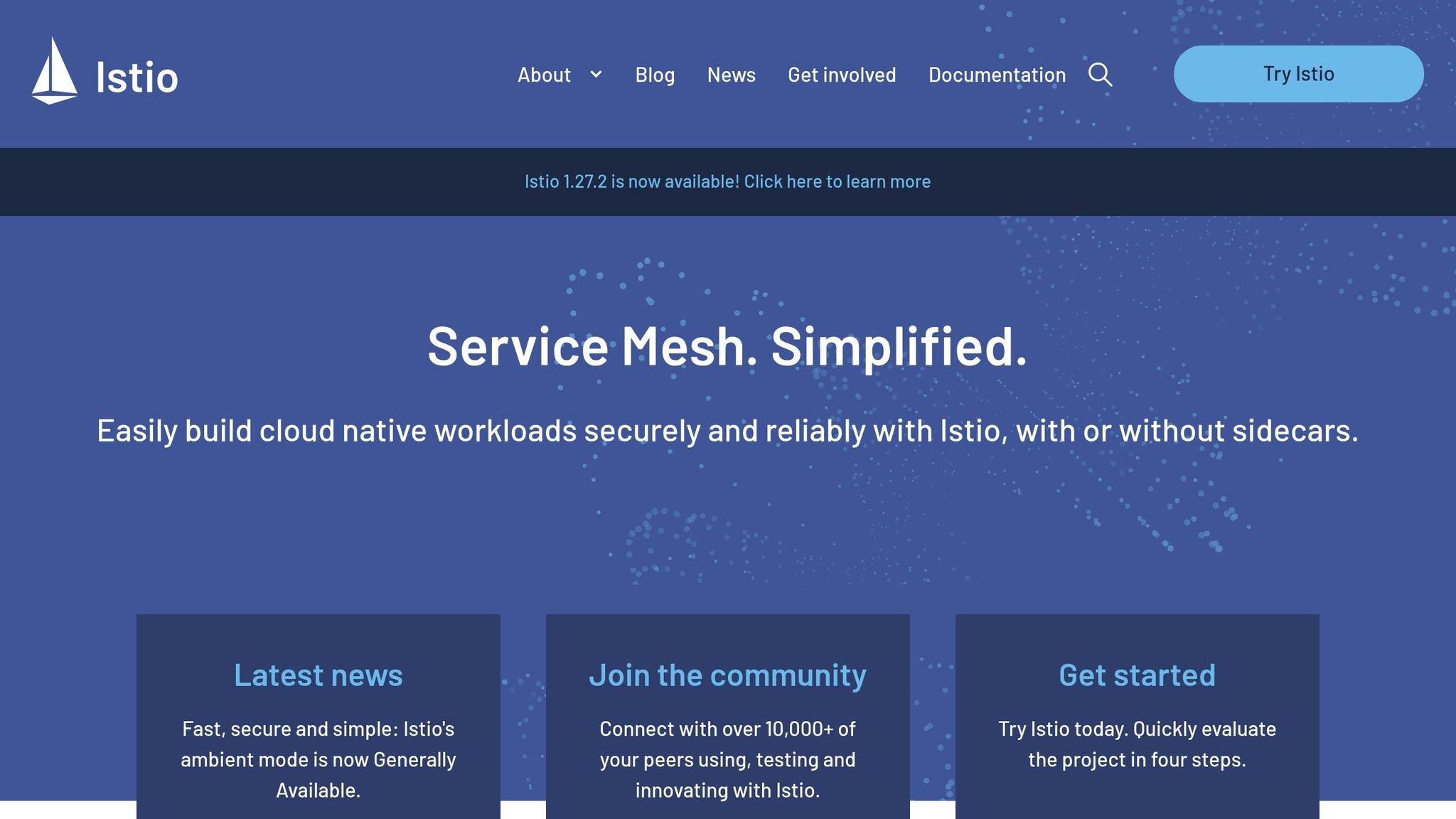
Istio is a robust service mesh designed for large enterprises operating in multi-cloud environments. As a CNCF Graduated project, it has gained the trust of major organisations like Google, IBM, Salesforce, T‑Mobile, and eBay.
Multi-cloud and Hybrid Support
Istio excels in multi-cluster setups, whether in public clouds or on-premises, thanks to its Ambient Mesh architecture. By separating the data plane from application pods, it reduces overhead and simplifies multi-cluster deployments. For hybrid environments, trust domain federation ensures secure communication between services - an essential feature for organisations adhering to UK and EU data residency regulations. This layered approach strengthens security without adding complexity.
Security Features
Istio goes beyond flexibility by securing interservice communication with advanced protocols. It automatically implements mutual TLS (mTLS) to encrypt service-to-service traffic, reducing the risk of man-in-the-middle attacks. Its access control and authentication systems align with zero-trust principles, helping organisations meet GDPR and other regulatory standards. Plus, Istio ensures consistent policy enforcement across diverse environments, whether you're running services on AWS, Azure, or Google Cloud.
Integration with Kubernetes and Major Cloud Providers
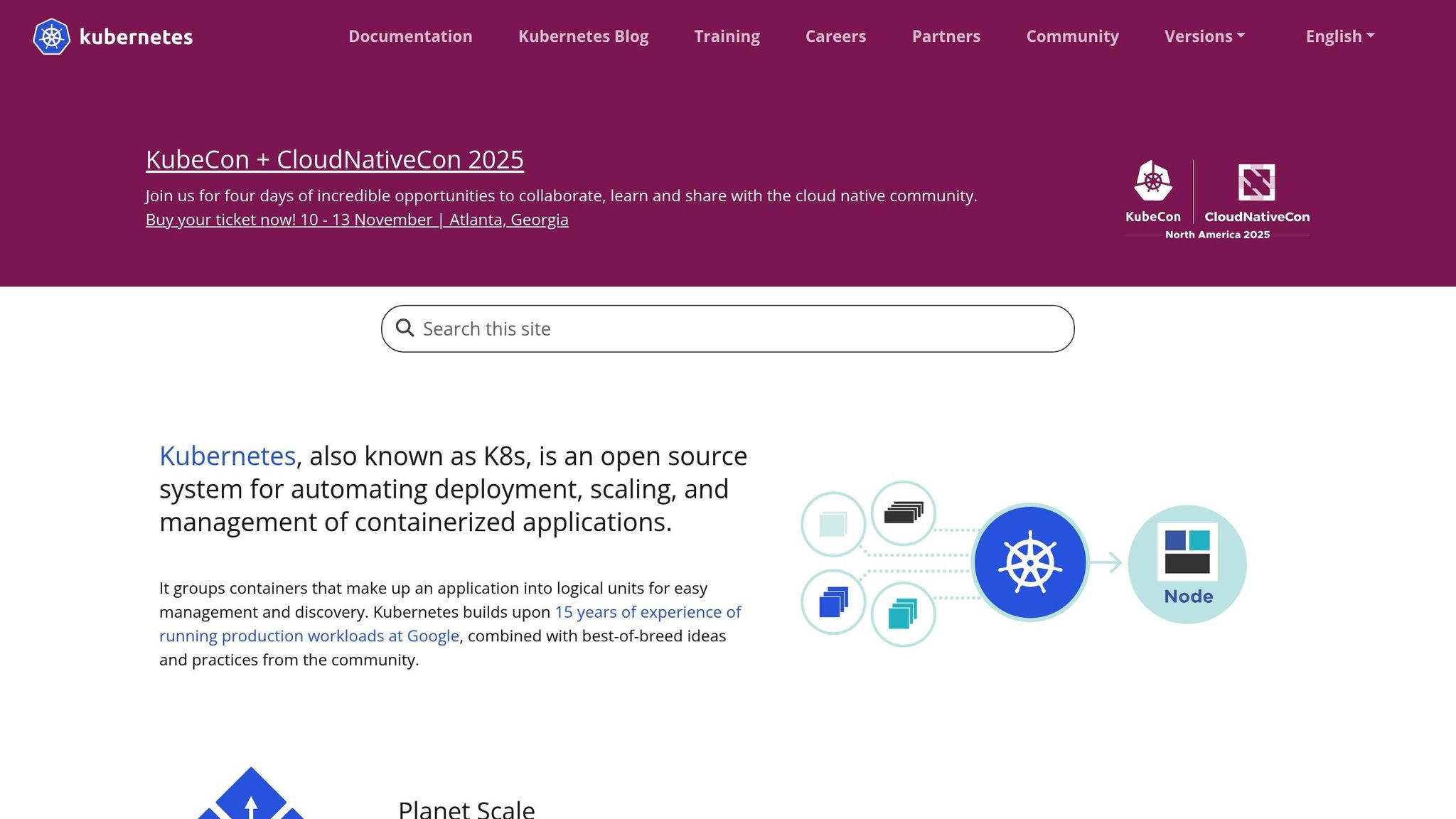
Built to work seamlessly with Kubernetes, Istio uses Kubernetes APIs for service discovery, configuration, and lifecycle management. Its cloud-agnostic design supports deployment across all major public cloud platforms, ensuring application portability and reducing the risk of vendor lock-in. For UK organisations, this flexibility is invaluable, but it’s worth noting that careful oversight is needed to balance performance with costs.
However, Istio’s sidecar proxies can introduce a steep learning curve and higher resource consumption. UK businesses aiming to manage costs effectively might consider working with experts like Hokstad Consulting to optimise infrastructure and streamline deployments.
2. Linkerd
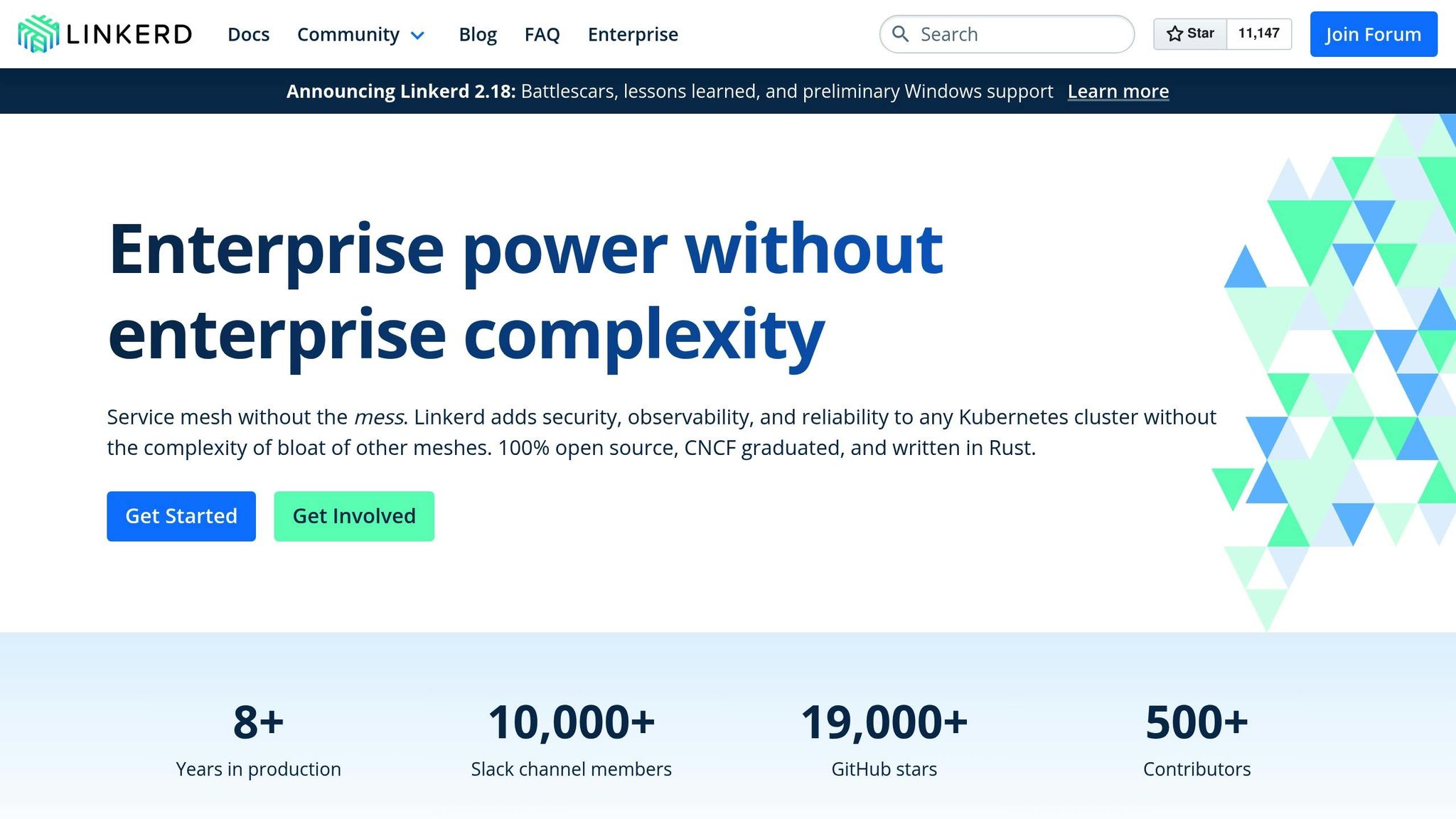
Linkerd stands out as a streamlined alternative to Istio, focusing on simplicity and performance. As the first-ever service mesh project and a CNCF graduate, Linkerd has earned a reputation for being reliable while keeping resource usage to a minimum - an appealing feature for budget-conscious businesses in the UK.
Multi-cloud and Hybrid Support
Linkerd is built to work seamlessly with Kubernetes clusters on major public cloud platforms like AWS, Azure, and Google Cloud. Its consistent performance across these managed services simplifies operations and reduces the need for extensive staff training. However, it doesn't offer native support for virtual machine (VM) workloads or handle complex cross-cloud networking scenarios without additional configuration[3].
Security Features
Security is a key focus for Linkerd, which automatically applies mTLS (mutual TLS) to all service-to-service communications. This built-in encryption reduces the risk of misconfigurations - often a weak point in more complex systems - and helps UK organisations meet critical regulations like GDPR[3].
While the default mTLS setup is robust, Linkerd doesn’t provide as much flexibility in policy management as some other service mesh options. This makes it ideal for teams that prefer secure defaults over the added complexity of custom policy configurations.
Traffic Management and Observability
Linkerd uses a lightweight, Rust-based micro-proxy to manage traffic with ultra-low latency. Features like load balancing, retries, and timeouts are handled efficiently, and integration with tools like Prometheus and Grafana offers real-time metrics tailored for UK businesses[3]. For organisations looking to optimise costs, Linkerd’s efficient design reduces resource demands while simplifying operations.
Integration with Kubernetes and Major Cloud Providers
Linkerd integrates effortlessly with Kubernetes, allowing for quick deployment through CLI or Helm charts. Features like automated sidecar injection and built-in observability tools simplify the setup process[3].
For UK companies seeking professional expertise, firms like Hokstad Consulting specialise in DevOps transformations and cloud cost engineering. Their guidance can help businesses implement Linkerd effectively, ensuring optimal performance and cost efficiency across multi-cloud environments. This ease of deployment and focus on efficiency make Linkerd a strong choice for teams prioritising simplicity and cost control.
3. Consul
HashiCorp's Consul stands out by bridging the gap between legacy systems and modern cloud-native applications. Unlike Istio and Linkerd, which are primarily focused on Kubernetes, Consul is designed to work across a broader range of environments. This makes it particularly valuable for UK businesses navigating the challenges of digital transformation, where legacy infrastructure often needs to coexist with newer, cloud-native systems.
Multi-cloud and Hybrid Support
One of Consul's key strengths is its ability to manage services across VMs, bare-metal servers, and Kubernetes clusters all at once[3]. This flexibility is essential for UK organisations that can't simply discard their existing infrastructure as they modernise. By enabling seamless service discovery and communication between workloads, Consul ensures a smoother transition to more advanced systems[2][3].
For companies operating across multiple regions or using different cloud providers, Consul's federation features are invaluable. These allow datacentres to connect while maintaining high availability. It's no surprise that major players like Adobe, Citadel, Roblox, SAP, and Deliveroo rely on Consul for managing their distributed infrastructures[4]. This adaptability also paves the way for Consul's strong focus on security.
Security Features
Consul places a high priority on security, embedding essential safeguards into its core functionality. With built-in mutual TLS (mTLS), all service-to-service communication is automatically encrypted[2][3]. On top of that, it offers fine-grained ACLs to control which services can communicate with each other.
This meticulous approach to policy management is especially important for UK organisations handling sensitive data or adhering to GDPR regulations. For industries like finance and healthcare, where data breaches can have severe consequences, Consul's service segmentation policies help contain potential threats by limiting lateral movement during security incidents[3].
Traffic Management and Observability
Consul also excels in traffic management, offering features like dynamic routing, load balancing, and support for canary and blue-green deployments[2][3]. These tools allow businesses to roll out updates and changes in distributed environments with minimal risk of disruption.
The platform integrates seamlessly with popular monitoring tools, providing clear insights into service health and traffic. For UK businesses pursuing multi-cloud strategies, this level of observability is critical for diagnosing and resolving issues that span across different environments.
Integration with Kubernetes and Major Cloud Providers
Consul's native Kubernetes integration allows it to manage both Kubernetes-based and external services within the same service mesh[2][3]. This dual capability is a game-changer for teams gradually migrating workloads to Kubernetes, as it ensures visibility and control over both modern and legacy systems.
Consul also offers official integrations with major cloud providers, including AWS, Azure, and Google Cloud, along with detailed deployment guides for each[2]. Its compatibility with the broader HashiCorp ecosystem - such as Terraform for infrastructure as code and Vault for secrets management - provides a cohesive toolset for managing infrastructure efficiently[2][3].
With 28,000 stars on GitHub, Consul benefits from an active and engaged community[4]. For UK organisations looking to maximise performance and cost efficiency, consulting firms like Hokstad Consulting can provide tailored implementation strategies for complex multi-cloud environments.
Need help optimizing your cloud costs?
Get expert advice on how to reduce your cloud expenses without sacrificing performance.
4. Cilium
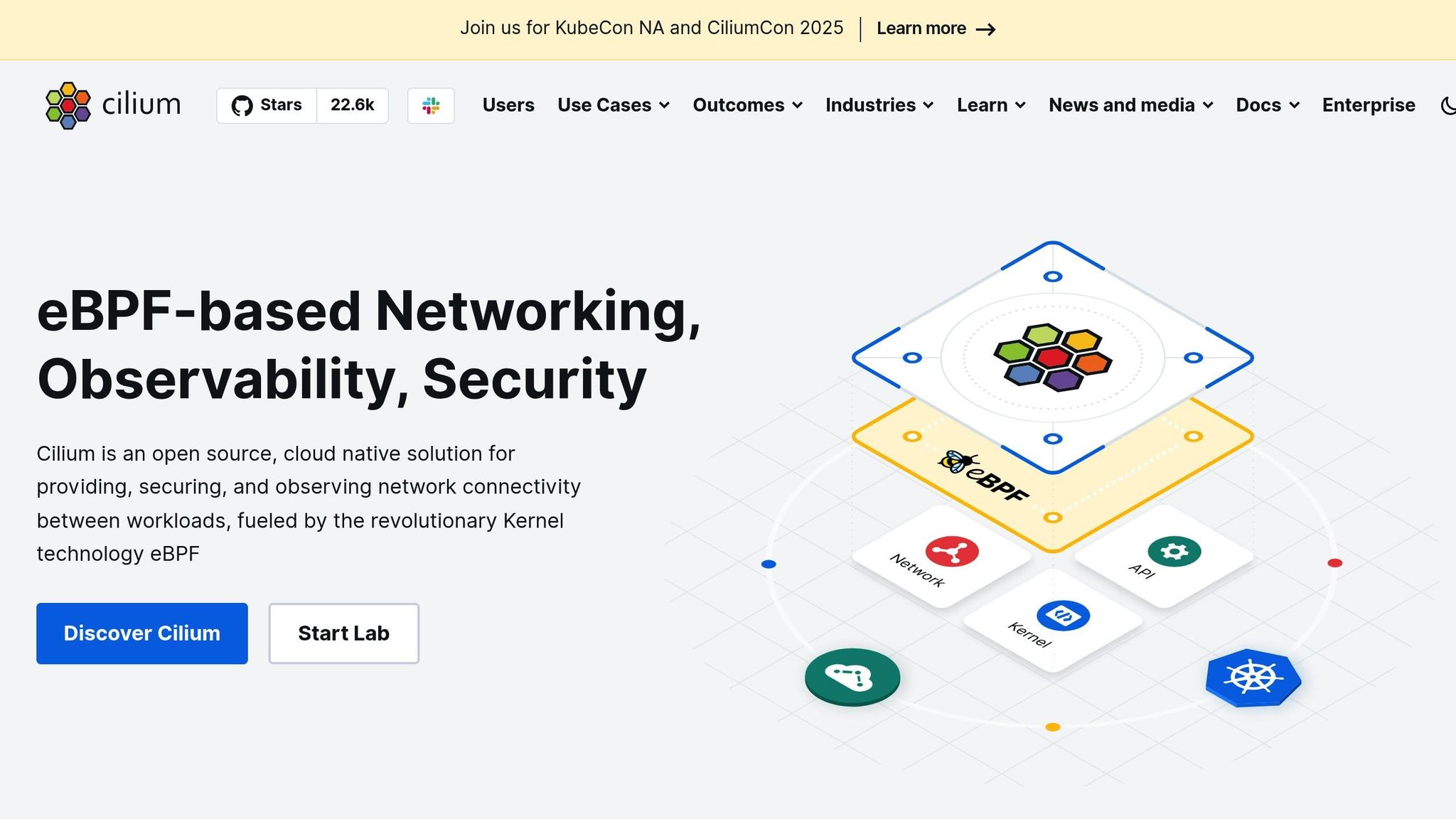
Cilium takes a different approach to service mesh architecture by using eBPF (extended Berkeley Packet Filter) technology, which operates directly within the Linux kernel. This eliminates the need for traditional sidecar proxies, reducing resource usage and cutting down on latency. For UK organisations managing large-scale distributed workloads, this sidecar-free design offers better performance and efficiency.
Multi-cloud and Hybrid Deployments
Cilium shines in multi-cloud and hybrid setups by maintaining consistent network policies and delivering strong observability across Kubernetes clusters. Whether your clusters are hosted on different cloud platforms or on-premises, Cilium’s architecture ensures smooth integration across public, private, and hybrid environments. Major companies like Adobe, Capital One, and Datadog have successfully deployed Cilium in production, with some implementations managing thousands of nodes and millions of endpoints. According to the CNCF's 2024 Cloud Native Survey, over 20% of organisations using service mesh technologies reported using Cilium in some capacity[2]. This broad adoption highlights its capabilities in handling complex, distributed environments.
Advanced Security Capabilities
Cilium offers robust security features, including API-aware network security policies that operate at the application layer. These policies allow precise control over service-to-service communication. It supports mutual TLS (mTLS) to encrypt traffic between services and provides flexible policy management, dynamically enforcing rules based on Kubernetes labels, namespaces, and service identities. By leveraging its eBPF-based architecture, Cilium ensures real-time enforcement and visibility without impacting performance - an essential advantage for organisations dealing with sensitive data or adhering to strict regulatory standards.
Traffic Management and Observability
In cloud-native environments, Cilium delivers detailed kernel-level metrics and flow logs, offering deep insights into traffic patterns, latency, and security events. It works seamlessly with tools like Prometheus and Grafana, enabling real-time monitoring and alerting. Additionally, Cilium simplifies traffic management with features like routing, load balancing, and network segmentation. These capabilities allow operators to effectively manage service-to-service communication across clusters and cloud platforms.
Kubernetes Integration and Cloud Compatibility
As a native Kubernetes CNI (Container Network Interface) plugin, Cilium integrates effortlessly into existing Kubernetes environments. It supports all major cloud providers, including AWS, Azure, and Google Cloud Platform, and works with managed services such as EKS, AKS, and GKE. Deployment is straightforward using Helm charts or cloud-specific add-ons, making multi-cloud adoption easier. For UK businesses looking to streamline their multi-cloud infrastructure, Cilium also supports CI/CD pipelines and automation through APIs and declarative policy management compatible with GitOps workflows. Consulting partners like Hokstad Consulting can provide tailored strategies to help organisations fully leverage Cilium’s advanced networking and security features while keeping cloud costs and deployment processes efficient.
5. Open Service Mesh (OSM)
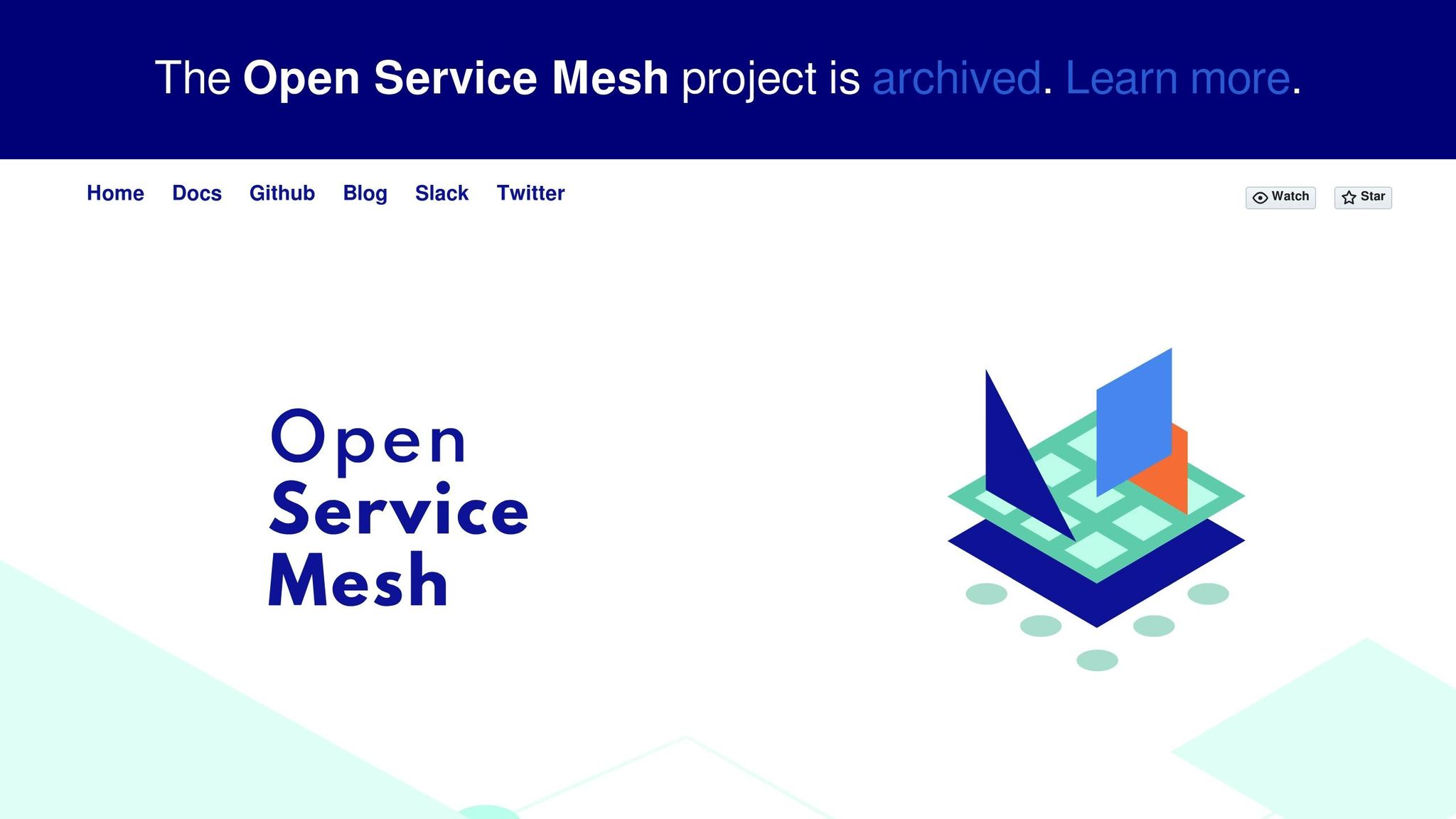
After exploring Consul and Cilium, let's turn to Open Service Mesh (OSM), a lightweight, Kubernetes-native service mesh that works well in multi-cloud setups.
Developed by Microsoft, OSM is designed to offer a streamlined, Kubernetes-focused solution for managing service-to-service communication. As part of the CNCF incubating projects, it's gained traction among UK organisations for its simplicity and effectiveness in multi-cloud environments. With over 3,000 stars on its GitHub repository [1], OSM benefits from an active community and consistent development.
Multi-cloud and Hybrid Support
One of OSM's key strengths is its cloud-agnostic nature, making it an ideal choice for businesses operating across various cloud platforms. It can be deployed on any Kubernetes cluster, whether it's hosted on AWS, Azure, Google Cloud, or even on-premises systems. Rather than offering complex multi-cluster management, OSM uses Kubernetes' native federation for cross-cluster communication. This approach ensures smooth integration while focusing on core features like security and visibility.
Security Features
OSM prioritises secure communication by automatically enabling mutual TLS (mTLS) and aligning with Kubernetes RBAC and Service Mesh Interface (SMI) standards. This setup allows for fine-grained access control, letting operators define which services can interact. These features are particularly useful for organisations needing to safeguard sensitive data and comply with regulations like GDPR.
Traffic Management and Observability
OSM provides robust traffic management capabilities, including traffic splitting, retries, timeouts, and circuit breaking, all managed through SMI APIs. For monitoring and visibility, it integrates seamlessly with tools like Prometheus and Grafana. These integrations offer real-time insights into service performance and traffic behaviour, while detailed metrics and traces help teams quickly identify and address issues.
Integration with Kubernetes and Major Cloud Providers
OSM’s deep integration with Kubernetes simplifies its deployment and management processes. While it's designed to be cloud-agnostic, it performs particularly well on Azure Kubernetes Service (AKS), ensuring consistent functionality across different infrastructures.
For UK businesses, consulting firms like Hokstad Consulting can assist in optimising OSM deployments and managing cloud-related costs efficiently.
Feature Comparison Table
After reviewing each service mesh tool individually, it's useful to compare how they perform across key areas for multi-cloud deployments. The table below provides a detailed comparison of Istio, Linkerd, Consul, Cilium, and Open Service Mesh (OSM), highlighting their core capabilities.
| Feature | Istio | Linkerd | Consul | Cilium | Open Service Mesh (OSM) |
|---|---|---|---|---|---|
| Multi-Cloud Support | Advanced multi-cluster and multi-cloud capabilities | Basic Kubernetes-focused support | Strong hybrid/multi-cloud with VM and Kubernetes integration | Good Kubernetes-focused support | Basic Kubernetes-native support |
| Security Features | mTLS, RBAC, fine-grained policies, robust authentication | Automatic mTLS, simple policy management | mTLS, ACLs, service segmentation, Vault integration | API-aware security, eBPF-based enforcement, mTLS | mTLS, SMI-based access control, secure defaults |
| Deployment Complexity | High – steep learning curve with many configuration options | Low – zero-config setup and easy installation | Moderate – requires knowledge of the HashiCorp ecosystem | Moderate – eBPF familiarity is helpful | Low – simple, lightweight deployment |
| Integration Options | Kubernetes, Prometheus, Grafana, Jaeger, major cloud providers | Kubernetes, Prometheus, Grafana | Kubernetes, AWS, Azure, GCP, HashiCorp tools | Kubernetes, Prometheus, Grafana, Envoy | Kubernetes, Prometheus, Grafana, SMI-compliant tools |
| Performance | Moderate – sidecar overhead, improving with Ambient Mesh | High – lightweight, Rust-based data plane | Moderate – sidecar model with VM support | High – eBPF provides low overhead | Moderate – lightweight with basic features |
| Observability | Deep tracing and metrics with advanced features | Built-in real-time metrics and dashboards | Good integration with HashiCorp monitoring tools | Deep kernel-level visibility and advanced metrics | Basic observability with Prometheus integration |
| Community Support | Large community, CNCF graduated project | Growing community, CNCF graduated project | Active community, CNCF incubating project | Active community, CNCF incubating project | Active community, CNCF sandbox project |
This table sets the stage for a deeper dive into the strengths and challenges of each tool, helping you decide which one aligns best with your organisation's needs.
Key Strengths and Limitations
Istio stands out for its comprehensive control and advanced features, making it a strong choice for organisations managing complex multi-cloud environments. However, its steep learning curve and higher infrastructure costs may require careful planning and management.
Linkerd is a great option for those seeking quick deployment and automatic mTLS. Its simplicity and lightweight design make it budget-friendly, though it may not meet the needs of more complex or feature-rich environments.
Consul excels in managing both VMs and containers across multiple clouds, offering a unified management approach. However, getting the most out of Consul often requires familiarity with the HashiCorp ecosystem, which can add to the learning curve.
Cilium delivers exceptional performance and security through its eBPF-based architecture, making it a go-to for security-conscious organisations. That said, it does require a solid understanding of advanced networking concepts.
Open Service Mesh is well-suited for lightweight Kubernetes-native deployments, offering minimal overhead and ease of use. However, its lack of advanced multi-cloud management features might limit its appeal for more complex setups.
For organisations in the UK looking to optimise their multi-cloud service mesh strategies while keeping infrastructure costs in check, Hokstad Consulting (https://hokstadconsulting.com) provides expert DevOps transformation and cloud cost engineering services to help achieve these goals.
Conclusion
Choosing the right service mesh hinges on your organisation's specific technical requirements and overall cloud strategy. In a multi-cloud, vendor-neutral environment, the best option is one that strikes a balance between advanced functionality and ease of deployment. Here's a quick rundown of popular options:
- Istio: A top choice for large enterprises managing complex multi-cloud architectures, offering extensive control and flexibility.
- Linkerd: Ideal for teams seeking simplicity and straightforward implementation.
- Consul: Suited for hybrid setups, seamlessly managing both VMs and containerised workloads.
- Cilium: Focused on high performance and security, leveraging its eBPF-based architecture.
- Open Service Mesh: A lightweight option tailored for Kubernetes-native environments.
While features are important, aligning your choice with your infrastructure, team skills, and strategic goals is equally critical. Consider factors like your team's capacity to adopt new technologies, the compatibility with your existing systems, and the potential impact on cloud costs and deployment efficiency.
For UK businesses, the stakes are particularly high. Managing multi-cloud environments comes with unique challenges, including regulatory compliance and keeping cloud expenses under control. A misstep in selecting the right service mesh can lead to skyrocketing costs and overly complicated infrastructure.
To navigate these complexities, Hokstad Consulting (https://hokstadconsulting.com) offers expert guidance in DevOps transformation and cloud cost optimisation. They specialise in delivering tailored solutions for public, private, hybrid, and managed hosting environments, helping organisations achieve significant cost savings while improving deployment cycles.
FAQs
What should you consider when selecting a service mesh tool for a multi-cloud setup?
When selecting a service mesh tool for a multi-cloud setup, there are several critical factors to weigh to ensure it aligns with your organisation’s requirements. First, check its compatibility with your current cloud platforms and infrastructure. The tool should enable smooth communication between services across different clouds without unnecessary complexity. Another key consideration is scalability, particularly if you anticipate your system expanding in the future.
Take a close look at the tool’s features, such as traffic management, security, observability, and fault tolerance, to see how they match up with your operational objectives. The ease of integration is another essential factor - does the tool streamline deployment and management processes? Also, assess the level of automation it offers, as this can significantly reduce manual effort. Lastly, ensure the tool is backed by strong support and documentation, so any challenges during implementation or ongoing use can be addressed effectively.
How do the security features of Istio, Linkerd, and Consul compare?
When it comes to security in multi-cloud environments, Istio, Linkerd, and Consul each bring something distinct to the table, catering to different organisational needs.
Istio shines with its advanced security features. It offers mutual TLS for encrypting service-to-service communication, fine-grained access controls, and robust identity management. This makes it a great choice for teams that need detailed customisation and tight control over their security setup.
Linkerd, on the other hand, focuses on simplicity and efficiency. Its automatic TLS encryption ensures secure traffic between services without adding unnecessary complexity. Lightweight and easy to deploy, it’s perfect for teams that value speed and straightforward implementation.
Consul blends service mesh functionality with a strong focus on zero-trust networking. It provides tools like service segmentation and identity-based policies, making it particularly appealing for organisations already using HashiCorp tools or those with advanced networking needs.
The best choice ultimately depends on your organisation’s priorities. If you need extensive customisation and control, Istio is a solid pick. For simplicity and performance, Linkerd is the way to go. And if you’re looking to integrate with HashiCorp tools or require advanced networking features, Consul is an excellent fit.
What challenges might arise when deploying Istio in a multi-cloud environment, and how steep is the learning curve?
Deploying Istio in a multi-cloud setup comes with its fair share of hurdles. One major challenge lies in its complexity. With a wide array of configuration options and advanced features, Istio can be daunting to learn. Gaining a solid grasp of its control plane, data plane, and traffic management policies often demands both time and specialised knowledge.
Another significant obstacle is integration across various cloud providers. Each cloud platform operates with unique networking and security frameworks, which can make configuring and deploying Istio a tricky endeavour. Ensuring that services across different clouds communicate smoothly and adhere to consistent policies adds another layer of difficulty.
To address these challenges, many organisations prioritise thorough planning, invest in proper training, and adopt Istio gradually to ensure a smoother implementation process.
